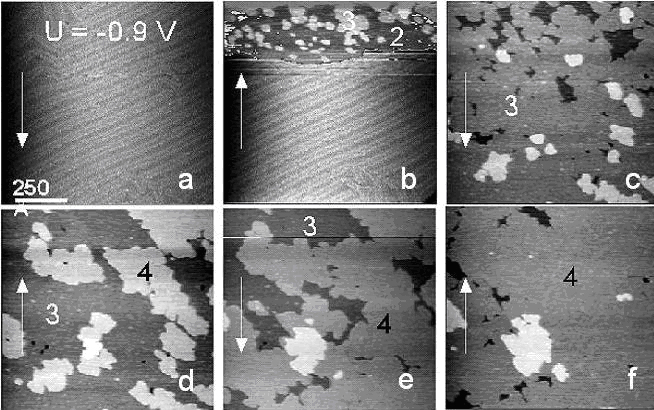Participants : P. Allongue, R. Cortès and F. Maroun
PhD students and Post-docs : H. Jurca (2009), G. Savidand (2007), P. Prod’homme (2005)
Ultrathin magnetic layers are important for spintronics and data storage. In this work, we correlate the morphology and structure of Co/Au(111) layer with their magnetic properties. In situ STM observations shown in Fig. 1 evidence that the growth follows a layer by layer process. Our XRD characterizations confirm that Co(0001) epitaxial layers are formed.
The thickness dependence of magnetization curves M – H presented in Fig. 2, were recorded in situ using magneto optical Kerr effect with the field applied perpendicular (top row) or parallel (bottom row) to the sample surface. These curves demonstrate that the Co layer is out of plane magnetized below 1.8 ML and becomes in plane magnetized above this critical thickness. This rather small critical thickness t* is assigned to the H- termination of the cobalt surface since protons are reduced (H+ + e- → 1/2 H2) during the deposition. In fact t* increases quite significantly upon adsorption of small molecules.
We have also investigated other systems such as Fe and FeNi alloy layers.

Figure 1 : Series of in situ STM images showing the nucleation and growth of a Co film on Au(111).

Figure 2 : Series of magnetization curves M – H recorded in situ for an increasing Co thickness (as indicated in ML in the middle row). The MOKE measurements are performed with the magnetic field applied out of plane (top row) or in plane (bottom row). The easy axis of magnetization switches from out of plane to in plane direction around 1.8 ML.
Publications :
– P. Allongue et Fouad Maroun, Electrodeposited Magnetic layers in the ultrathin limit, Material Research Society (MRS) Bulletin, 35 (2010) 761-770
doi:10.1557/mrs2010.505
– P. Allongue, F. Maroun, H. F. Jurca, N. Tournerie, G. Savidand, and R. Cortes, "Magnetism of electrodeposited ultrathin layers : Challenges and opportunities," Surf. Sci. 603 (10-12), 1831-1840 (2009).
http://dx.doi.org/10.1016/j.susc.2008.11.040
– P. Allongue, F. Maroun, Electrodeposition of two dimensional magnetic nanostructures on single electrode surfaces, Electrocrystallization and Nanotechnology, édité par G. Staikov, Wiley-VCH, Weinheim (2007), chapitre 11, pp. 217-241
– P. Prod’homme, F. Maroun, R. Cortès, P. Allongue, J. Hamrle, J. Ferré, J. P. Jamet, N. Vernier, Preparation, characterization and magneto optical investigations of electrodeposited Co/Au films, J. Magn. Magn. Mater. 315 (2007) 26-38
http://dx.doi.org/10.1016/j.jmmm.2007.02.199
– P. Allongue, L. Cagnon, C. Gomes, A. Gundel, and V. Costa, "Electrodeposition of Co and Ni/Au(111) ultrathin layers. Part I : nucleation and growth mechanisms from in situ STM," Surf. Sci. 557 (1-3), 41-56 (2004).
http://dx.doi.org/10.1016/j.susc.2004.03.016
– A. Gundel, T. Devolder, C. Chappert, J. E. Schmidt, R. Cortes, and P. Allongue, "Electrodeposition of Fe/Au(111) ultrathin layers with perpendicular magnetic anisotropy," Physica B-Condensed Matter 354 (1-4), 282-285 (2004).
http://dx.doi.org/10.1016/j.physb.2004.09.068
– L. Cagnon, T. Devolder, R. Cortes, A. Morrone, J. E. Schmidt, C. Chappert, P. Allongue, "Enhanced perpendicular magnetic anisotropy in electrodeposited Co/Au(111) layers", Phys. Rev. B 63 (2001) 104419
http://link.aps.org/doi/10.1103/PhysRevB.63.104419

